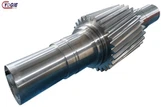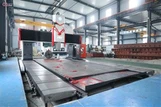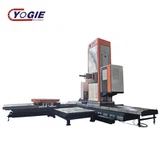Luoyang Yujie Industry&Trade Co., Ltd is one of the most experienced manufacturers and suppliers of custom steel herringbone gear in China. Please feel free to buy cheap custom steel herringbone gear for sale here from our factory. All customized products are with high quality and competitive price.
Products Description

Herringbone (Double Helical) Gear is a type of gear that is a side-by-side arrangement of two helical gears of opposing hands. The side thrust of one half of a double helical gear is balanced by the side thrust of the other half, which implies that double helical gears may be employed in torque gearboxes without requiring a big thrust bearing. In heavy-duty machinery, double helical gears or herringbone gears are always employed.
A herringbone gear is a combination of double helical gears with two helices arranged on opposite sides of the hand. The teeth of the herringbone gears are arranged at an angle called the helix angle, with no gaps between the left and right helixes, appearing in the shape of the letter "V" These letters together form a pattern that resembles a fishbone structure.
Since this structure has more than two teeth meshing with each other at the same time, the advantage is that the power transmission is smooth.The angled teeth of the herringbone gear help generate axial force and heat that is proportional to the magnitude of the helical tangent. The angle between the helix and the axis of rotation is 45 degrees, however, larger helix angles provide higher speeds. The arrangement of the two teeth of the herringbone gear counteracts the thrust exerted on each other, giving the advantage of smooth operation even at higher speeds.

herringbone gear and pinion

applications
Herringbone gears find applications in various industries, including automotive, power generation, marine, aerospace, and heavy machinery. They are commonly used in gearboxes, transmissions, pumps, compressors, turbines, and other mechanical systems that require high-performance gearing.
Advantages of herringbone gears
Steel
Quenched and tempered steel: such as 45# steel, 35SiMn, 42SiMn, etc. The price of 45# steel is relatively low. After quenching and tempering, it can obtain certain strength and toughness. It is suitable for some herringbone gears with medium load and not very high precision requirements. Alloy quenched and tempered steels such as 35SiMn and 42SiMn have better comprehensive mechanical properties than 45# steel, have higher strength and wear resistance, and can be used in occasions with large loads.
Carburizing steel: such as 20Cr, 20CrMnTi, etc. After carburizing and quenching, this type of steel has high surface hardness and good wear resistance, and the core has good toughness and can withstand large impact loads. It is often used for high-speed, heavy-loaded and wear-resistant herringbone gears, such as some large industrial transmission equipment.
Alloy cast steel: such as ZG 40Mn2, ZG 35SiMn, ZG 42SiMn, etc. Alloy cast steel has high strength and good toughness. It can be cast into large gears with complex shapes. It is suitable for manufacturing some large and heavy-loaded herringbone gears, especially those that are difficult to manufacture by forging.
Cast iron
Gray cast iron: such as HT250, HT300, etc. Gray cast iron has good casting performance and low cost. It has good shock absorption and wear resistance, but its strength is relatively low. It is generally used for light-loaded, low-speed, and low-precision herringbone gear transmissions, such as some small simple mechanical equipment.
Ductile iron: such as QT500-7, QT600-3, etc. The mechanical properties of ductile iron are greatly improved compared with gray cast iron. It has higher strength, toughness and wear resistance. It can partially replace steel to manufacture herringbone gears. It is widely used in some occasions where cost is required and the load is not particularly large.
machining processings of herringbone gear

Material Selection:
Choose a suitable material for the gear based on the application requirements. Common materials include alloy steels, carbon steels, and stainless steels.
Blank Preparation:
Start with a cylindrical or disk-shaped blank of the selected material. This blank will be turned on a lathe to achieve the desired outer diameter.
Turning:
Use a lathe to turn the blank to the required diameter. This step ensures uniformity and prepares the blank for subsequent machining processes.
Gear Hobbing:
Hobbing is a common process for cutting gear teeth. A hobbing machine equipped with a hob (a cutting tool) is used to gradually cut the teeth into the cylindrical blank. The herringbone shape requires special hobs that can cut in both directions.
Gear Shaping or Milling:
Alternatively, gears can be shaped or milled to create the herringbone profile. Gear shaping or milling machines use cutters to remove material and form the gear teeth. This process is slower than hobbing but can be used for herringbone gears.
Heat Treatment:
After the gear teeth are formed, the gears typically undergo heat treatment processes such as carburizing or quenching to enhance hardness and durability.
Grinding:
Precision grinding is often employed to ensure the accurate and smooth profile of the gear teeth. This step helps in achieving the desired gear tooth profile and surface finish.
Quality Inspection:
Conduct thorough quality inspections using tools like coordinate measuring machines (CMM) to verify the gear dimensions, tooth profile, and other critical parameters.
Assembly:
If the gear is part of a larger system, assemble it with other components, such as shafts and bearings, as required for the specific application.
Surface Finishing:
Depending on the application, additional surface finishing processes like shot peening or polishing may be performed to improve the gear's surface integrity.
Competitive Advantages
☆Both large module and large diameter are available.
☆High precision, up to 0.05mm
☆Quality control and management of the whole production process, including ingot smelting, forging, heat treatment, machining, and a strictly final inspection before delivery.
☆Excellent product quality and service, competitive price, "in-time" delivery.
FAQ
FAQ
Q: Are you trader or factory?
Q: What kind of service can you provide?
Q: Will weld inspection and paint thickness inspection be performed?
A: Yes. We also support third-party testing.
Hot Tags: custom steel herringbone gear, manufacturers, supplier, factory, customized, cheap, price, in stock, for sale, casting hardened gear wheel, Custom Steel Herringbone Gear, ring gear, slewing bearing external gear, slewing bearing internal gear, wheel gear
















